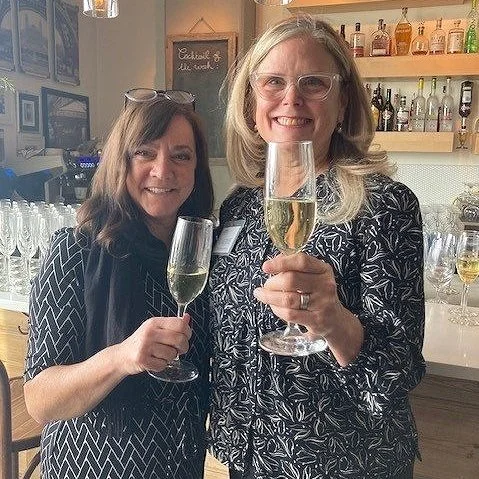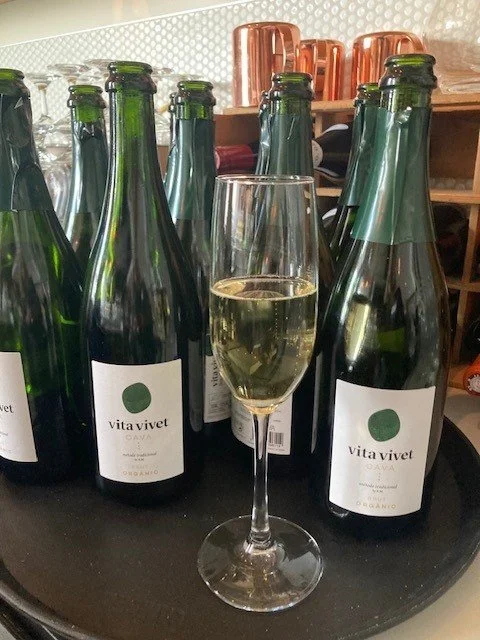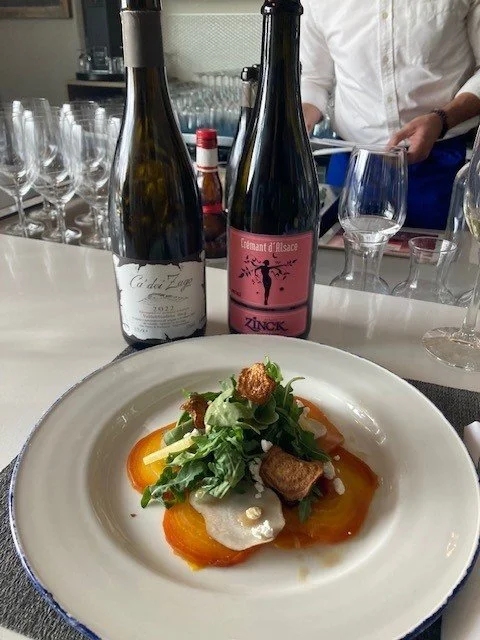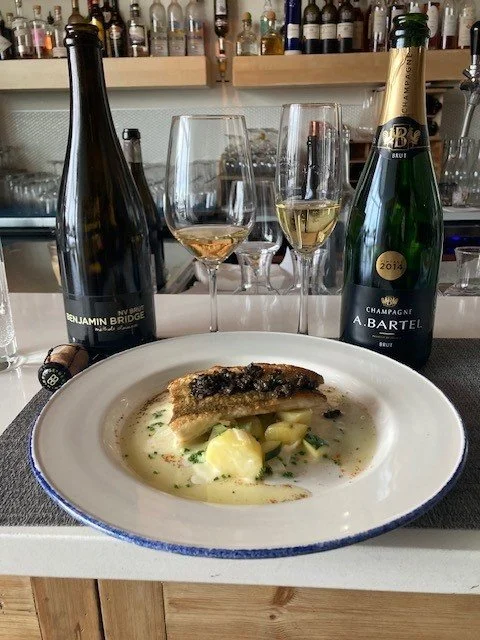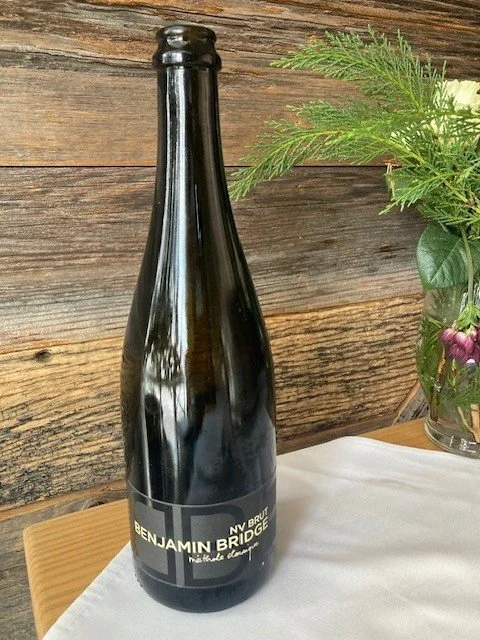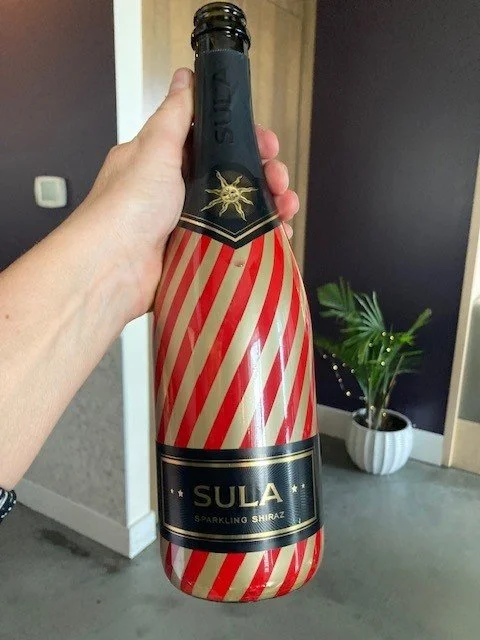Bubbles Brunch - Tasting Outside the Lines!
What an honour to be invited back to host the Holidays Bubbly Brunch for the Friends of the Vine wine society. 2024 marks my third year hosting. It has become the event that unofficially launches my holiday calendar. This year I teamed up with my good friend Ann Spavor of Crush Imports - one of Canada’s top wine agencies. The event is held at Cassis Bistro, known for its unpretentious French cuisine. Although the restaurant is normally closed at lunch, owner Gilles Brassart, opened especially for this event. I had so much fun finding wines mainly from the Crush Imports portfolio to pair with Executive Chef Dominique Moussu’s menu.
Three Course Menu created by Dominique Moussu
Glasses of Vita Vivet Cava waiting guests arrival.
The three course menu included a reception wine - Vita Vivet Cava Brut from the Cataluña region in northeast Spain. The Vita Vivet Cava Brut is a traditional blend of Xarel-lo, Parellada and Macabeo grapes. It’s fresh, crisp style was a good way to start things off and get everyone’s palates ready for what’s to come.
The word "Cava" means "cave" in Catalan, honouring its origins in Catalonia. It is crafted using the same method as Champagne. It undergoes a second fermentation in the bottle, during which sugar and yeast are added to the still wine before the bottle is sealed with a cork. Click here to learn more about the Cava.
FIRST COURSE - Italy versus France
For the first course, two sparkling wines - Ca dei Zago Prosecco DOCG and Domaine Zinck Cremant d’Alsace Rose - were chosen to pair with either the Mushroom Ravioli or the Heirloom Beet Salad . The wines couldn’t be more different. The Ca’ dei Zago Prosecco is a Colfondo, a term that translates to “in the bottom.” This refers to the secondary fermentation occurring directly in the bottle, a process noted on the label as “Rifermentato in Bottiglia” Colfondo Prosecco is typically frizzante (lightly sparkling) and has a cloudy appearance due to the sediment it retains. Its flavour profile leans more sour than sweet, which might not appeal to everyone—but I absolutely love it! Ca’ dei Zago is an excellent example of this style. I often think of Colfondo as the “cerebral Prosecco,” as there’s so much complexity.
The Domaine Zinck Crémant d’Alsace Rosé gave the Ca’ dei Zago Prosecco some serious competition. Alsace, located in the northeastern corner of France, is the country’s second most northern wine region (after Champagne). It shares a border with Germany to the east and Switzerland to the south. The winery was founded in 1964 by Paul Zinck with just 2.4 hectares of vineyards. Today, under the leadership of Paul’s son, Philippe Zinck, the estate spans 30 hectares, with Philippe serving as head winemaker.
Crémant refers to French sparkling wines made outside the Champagne region, and Crémant d’Alsace specifically means sparkling wine from Alsace. Like Champagne, it is produced using the Traditional Method. This 100% Pinot Noir has an excellent structure, with aromas and flavours of citrus, red apple, strawberry, and brioche. It paired beautifully with both the heirloom beet salad and the wild mushroom ravioli.
SECOND COURSE - Canada versus Champagne
For the second course, there was a choice between Beef Striploin and Baked Pickerel. Most guests chose the beef but I picked the pickerel. I paired the Benjamin Bridge Methode Classique Non-Vintage from Nova Scotia, Canada and the Bartel Brut 2014 Vintage Champagne from Champagne, France.
Benjamin Bridge Winery is located in the Gaspereau Valley, a small 12-kilometer region within Nova Scotia’s larger Annapolis Valley. The area is home to 19 wineries producing 1.9 million liters of wine annually. With its cool maritime climate, Nova Scotia is ideal for crafting sparkling wines, and Benjamin Bridge has become renowned for its expertise in this style. This sparkling wine is a blend of Pinot Noir, Chardonnay, Pinot Meunier, L’Acadie Blanc, Vidal, and Seyval.
I was impressed by its complexity. The nose offers notes of lemon rind, green apple, and a touch of minerality, while the palate delivers vibrant flavors of lemon, Granny Smith apple, and honeydew melon, all with remarkable intensity.
I love Champagne! It’s worth noting that while all Champagne is sparkling wine, not all sparkling wine qualifies as Champagne. To earn the name, it must come from the Champagne region in northeastern France and be produced using the Traditional Method.
Bartel is a family-owned Champagne house founded by Andreas Bartel, a German-born winemaker who moved to Champagne in 1996 and launched his own label in 2004. Renowned for his commitment to organic and biodynamic farming and a low-intervention winemaking approach, Bartel creates wines that are both expressive and elegant.
This 2014 vintage Champagne is crafted from a blend of 88% Pinot Noir and 12% Chardonnay, sourced from hand-picked grapes grown on three hectares of vineyards in Ville-sur-Arce, located in the Côte des Bar—the southernmost subregion of Champagne.
This grower champagne was fresh and vibrant, offering complex aromas of red fruits, citrus lemon, and peach, interwoven with rich notes of brioche, biscuit, and bread. On the palate, it was generous and full-bodied, with a round, supple texture and a long, satisfying finish.
THIRD COURSE - Australia versus India
For the third and final course, I selected the Dunes & Greene Brut Non-Vintage and the Sula Sparkling Shiraz. Guests were served both wines but had their choice between an apple tart or a chocolate trio. Only one of the wines was going to be a good pairing. Guests didn’t seem to mind this at all. Turns out they were curious about what I meant by a bad pairing!
Dunes & Greene Brut is from south Australia. It is owned by the Hills-Smith family, owners of the renowned Yalumba winery. Natalie Fryar, senior sparkling winemaker at Yalumba makes this Dune & Greene. This sparkling is a blend of 69% Pinot Noir and 31 % Chardonnay. It was a full flavoured sparkling with aromas of lemon zest, fresh strawberries and cream. It paired extremely well with the apple tarte.
Our final sparkling wine was the Sula Sparkling Shiraz from India. 99% of the guests didn’t realize that they made wine in India! Sula Vineyards was founded in 1996 by Rajeev Samant, a native of Mumbai, and California winemaker Kerry Damsky. Rajeev discovered his passion for wine while studying economics and computer science at Stanford University in California, where he crossed paths with Kerry Damsky.
Sula (which means son) has 68% of the market share of the wine industry in India. The winery is located in the Nashik region, sometimes called the Wine Capital of India. It is two hours northeast of Mumbai. The town is at an altitude of 2200 feet. This altitude helps the grapes maintain acidity which is critical in the Indian hot and humid climate.
With it’s flavours of pomegranate, blackberry and black cherry, it paired very well with the chocolate trio.

